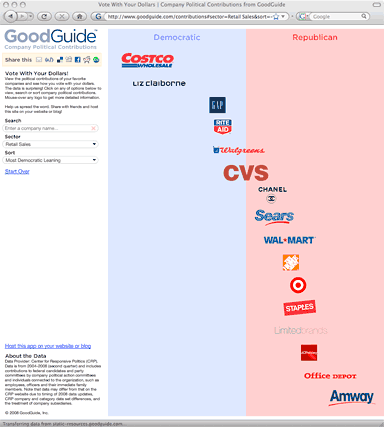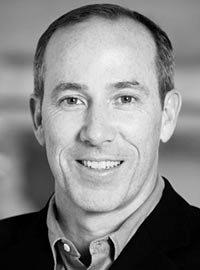What’s in that stuff? Ask GoodGuide
Fretting over the hidden health, environmental, and social costs of the things you buy? Professor-cum-entrepreneur Dara O’Rourke felt a need, and filled it
| 05 November 2008
 In keeping with its mission of conscious consumption, GoodGuide makes it easy for shoppers to “vote with their dollars” by showing the political contributions of scores of companies in more than a dozen industries. The page above sorts major retailers from most Democratic-leaning (Costco, top left) to most Republican (Amway, bottom right)
In keeping with its mission of conscious consumption, GoodGuide makes it easy for shoppers to “vote with their dollars” by showing the political contributions of scores of companies in more than a dozen industries. The page above sorts major retailers from most Democratic-leaning (Costco, top left) to most Republican (Amway, bottom right)BERKELEY — As an academic researcher, Dara O’Rourke has spent more than a decade flying to far-flung corners of the world to suss out the impacts of global supply chains on workers and the environment. But it took his students — and his 3-year-old daughter — to bring home the pressing need for product information that helps everyday consumers do right by their families, their planet, and their personal convictions.
Now O’Rourke, an associate professor of environmental and labor policy, has launched an early-beta version of GoodGuide.com, a conscious-consumption website that bills itself as “the world’s largest and most reliable source of information” for shoppers who care as much about values as they do about value. The fledgling site already delivers a wealth of data on more than 60,000 personal-care and household-chemical products, and O’Rourke and his staff are adding more categories, and new ways to access the site’s data, as they build toward the next generation.
“People want to know much more about their products than just the price and just the brand,” declares O’Rourke, who took a leave from his regular job in an effort to meet the demand.
In addition to teaching classes on topics like environmental justice and global industrial production, O’Rourke has been a consultant to the United Nations, the World Bank, and the Environmental Protection Agency on pollution prevention, industrial ecology, sustainable development, and corporate social responsibility. With GoodGuide, he’s aiming to shape his own expertise — and that of a “team of Ph.D.s” proficient in both content and technical issues — to what he sees as a bull market for safe, sustainable shopping.
“Week after week the public is hearing about, and worrying about, the health and environmental and social impacts of what they’re consuming,” he explains. “So what we’ve tried to do over the last two or three years is to take rigorous academic work, government data, nongovernmental-organization data, private-research-firm data, and media information, and connect it all in a way that’s accessible, understandable, simple, and easy to use — and that can actually empower the public to both get access to much better information and ultimately make much better decisions about products and companies.”
 Dara O'Rourke
Dara O'RourkeO’Rourke first detected the surging interest in socially conscious consumption about four years ago.
“I’d get back to Berkeley from a trip to China,” he says, “and I’d give a lecture to my students or give a talk around the Bay Area, and the first question at the end of my talk would be, Okay, okay, ‘supply chain’ this and ‘lifecycle’ that, but what we really want to know is: Which pair of shoes should we buy? Should we buy Nike or Reebok if we care about labor rights? Should I buy Apple or Dell if I care about the environment? Should I buy Peet’s or Starbucks if I care about fair trade?”
The epiphany, though, came two years later, in the person of his small daughter, Minju.
“I was putting sunscreen on her face when she was 3, and just kind of stopped and said, Okay, what’s in this chemical that I’m slathering all over her face every morning before I send her out to play? And I had never thought about it,” he says, his amazement still palpable. “You know, I have a Ph.D., and I teach in the department of environmental science, and I’d just never thought about it. I just assumed, here’s a product, the top-selling kids’ sunscreen in America, on the shelf of my local store — it must be safe.”
A bit of investigation, however, revealed it contained a toxic ingredient. And O’Rourke’s realization that “the U.S. government has not been doing its job to protect us from potentially hazardous products,” he says, “really was a wake-up call.”
“I was hearing it from my students, I was hearing it from the public, and then I felt it myself,” he says. “It’s almost like we’re in the Dark Ages on these products we’re consuming, that we’re putting in, on, and around ourselves and our children. We know almost nothing about them. We don’t know where they come from, we don’t even know who made them, let alone what’s in them or what their impacts are. And that really made it visceral for me.”
O’Rourke set about gathering fellow academics from Berkeley, MIT, and Harvard, and technology and consumer professionals from firms like Google, Amazon, and eBay, to create GoodGuide, which now employs 11 full-time staffers and a dozen or so part-timers at its San Francisco offices.
Even in its beta form, the site offers consumers not just one-stop shopping for information on toxics, animal-testing practices, workers’ rights, and even political contributions — “if you spent 20 hours online,” O’Rourke estimates, “you could probably piece together 10 or 20 percent of what we have in our system” — but the kind of in-depth analysis they won’t find anywhere else.
After doing product assessments in three broad categories — health hazards, environmental lifecycles, and social impacts — the GoodGuide team identifies key issues of concern in each category, compiles the best available information on those issues, then runs it all through a set of algorithms that weight and rate the data. For a bottle of baby shampoo, for example, the key issues are fairly simple — mostly the manufacture of the active chemical, along with packaging and disposal. For laptop computers and other “big ticket” items, it’s crucial to look at the pre-manufacturing stage — that is, the selection of raw materials that go into the laptop — in order to know if they’re clean and green.
“We’re trying to do the science to determine what really matters in the product category, and then we go and get the best data in the world on those performance criteria,” O’Rourke says. “We deliver them to you, and let you filter what we think matters scientifically with what matters to you personally.”
Users can simply ask for recommendations in a given category, like shampoo or toothpaste. Or they can browse by category, an option that leads to a list of products and ratings, as well as the opportunity to drill deeper into the database by clicking on additional links.
Eventually, shoppers with cellphones will be able to find the safest detergent, say, from a particular store’s inventory while pushing their carts through the households aisle. And those with iPhones and other such GPS-equipped gizmos will have the option of being redirected to green, locally owned stores nearby that carry the products they want.
“It’s really important that we actually get this to you right at the moment you’re making a decision about a product,” says O’Rourke, who this week launched two relatively modest mobile applications — one for iPhones, the other for text-messaging devices. The phased rollout is a reflection of what he calls “the startup culture in the Bay Area, which says put things out early and watch how people use them.”
O’Rourke views the enterprise, which operates under a licensing agreement with the university, as a dot-com with a difference. “We didn’t want this to be a traditional for-profit company,” he explains. “We wanted to be really clear on our social mission, which is an educational and empowerment mission — to get this information out to the public, and to motivate greater transparency on the part of industry, and to help people make better decisions. That’s our No. 1 goal.”
Meanwhile, the first-time entrepreneur is eager to see GoodGuide fly on its own. “Right now I’m kind of doing everything,” he says, from sweeping floors and stuffing envelopes to content, research, and fundraising. He hopes to have people on board by January to handle the day-to-day management, and looks forward to returning to campus in time for the 2009 fall semester.
“Some days,” he admits, “I pine for sitting alone in my office in Giannini Hall and just thinking and writing and working.”

